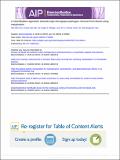| dc.contributor.author | Hou, Han Wei | |
| dc.contributor.author | Gan, Hiong Yap | |
| dc.contributor.author | Bhagat, Ali Asgar S. | |
| dc.contributor.author | Li, Leon Daliang | |
| dc.contributor.author | Lim, Chwee Teck | |
| dc.contributor.author | Han, Jongyoon | |
| dc.date.accessioned | 2014-05-09T15:02:10Z | |
| dc.date.available | 2014-05-09T15:02:10Z | |
| dc.date.issued | 2012-05 | |
| dc.date.submitted | 2012-02 | |
| dc.identifier.issn | 19321058 | |
| dc.identifier.uri | http://hdl.handle.net/1721.1/86903 | |
| dc.description.abstract | Sepsis is an adverse systemic inflammatory response caused by microbial infection in blood. This paper reports a simple microfluidic approach for intrinsic, non-specific removal of both microbes and inflammatory cellular components (platelets and leukocytes) from whole blood, inspired by the invivo phenomenon of leukocyte margination. As blood flows through a narrow microchannel (20 × 20 µm), deformable red blood cells (RBCs) migrate axially to the channel centre, resulting in margination of other cell types (bacteria, platelets, and leukocytes) towards the channel sides. By using a simple cascaded channel design, the blood samples undergo a 2-stage bacteria removal in a single pass through the device, thereby allowing higher bacterial removal efficiency. As an application for sepsis treatment, we demonstrated separation of Escherichia coli and Saccharomyces cerevisiae spiked into whole blood, achieving high removal efficiencies of ∼80% and ∼90%, respectively. Inflammatory cellular components were also depleted by >80% in the filtered blood samples which could help to modulate the host inflammatory response and potentially serve as a blood cleansing method for sepsis treatment. The developed technique offers significant advantages including high throughput (∼1 ml/h per channel) and label-free separation which allows non-specific removal of any blood-borne pathogens (bacteria and fungi). The continuous processing and collection mode could potentially enable the return of filtered blood back to the patient directly, similar to a simple and complete dialysis circuit setup. Lastly, we designed and tested a larger filtration device consisting of 6 channels in parallel (∼6 ml/h) and obtained similar filtration performances. Further multiplexing is possible by increasing channel parallelization or device stacking to achieve higher throughput comparable to convectional blood dialysis systems used in clinical settings. | en_US |
| dc.description.sponsorship | Singapore-MIT Alliance for Research and Technology (SMART) Centre (BioSyM IRG) | en_US |
| dc.description.sponsorship | Massachusetts Institute of Technology. Microsystems Technology Laboratories | en_US |
| dc.description.sponsorship | United States. Defense Advanced Research Projects Agency (DARPA DLT (Dialysis-Like Therapeutics) program, under SSC Pacific grant N66001-11-1-4182) | en_US |
| dc.language.iso | en_US | |
| dc.publisher | American Institute of Physics | en_US |
| dc.relation.isversionof | http://dx.doi.org/10.1063/1.4710992 | en_US |
| dc.rights | Article is made available in accordance with the publisher's policy and may be subject to US copyright law. Please refer to the publisher's site for terms of use. | en_US |
| dc.source | MIT web domain | en_US |
| dc.title | A microfluidics approach towards high-throughput pathogen removal from blood using margination | en_US |
| dc.type | Article | en_US |
| dc.identifier.citation | Wei Hou, Han, Hiong Yap Gan, Ali Asgar S. Bhagat, Leon D. Li, Chwee Teck Lim, and Jongyoon Han. “A Microfluidics Approach Towards High-Throughput Pathogen Removal from Blood Using Margination.” Biomicrofluidics 6, no. 2 (2012): 024115. | en_US |
| dc.contributor.department | Harvard University--MIT Division of Health Sciences and Technology | en_US |
| dc.contributor.department | Massachusetts Institute of Technology. Department of Biological Engineering | en_US |
| dc.contributor.department | Massachusetts Institute of Technology. Department of Electrical Engineering and Computer Science | en_US |
| dc.contributor.mitauthor | Hou, Han Wei | en_US |
| dc.contributor.mitauthor | Gan, Hiong Yap | en_US |
| dc.contributor.mitauthor | Li, Leon Daliang | en_US |
| dc.contributor.mitauthor | Han, Jongyoon | en_US |
| dc.relation.journal | Biomicrofluidics | en_US |
| dc.eprint.version | Final published version | en_US |
| dc.type.uri | http://purl.org/eprint/type/JournalArticle | en_US |
| eprint.status | http://purl.org/eprint/status/PeerReviewed | en_US |
| dspace.orderedauthors | Wei Hou, Han; Gan, Hiong Yap; Bhagat, Ali Asgar S.; Li, Leon D.; Lim, Chwee Teck; Han, Jongyoon | en_US |
| dc.identifier.orcid | https://orcid.org/0000-0001-7215-1439 | |
| mit.license | PUBLISHER_POLICY | en_US |
| mit.metadata.status | Complete | |
